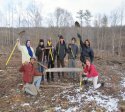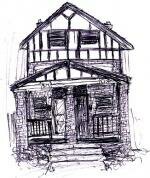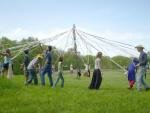Who decides? Three communes models
In the story i tell, at it’s inception Twin Oaks wanted a decision model which was better than simple democratic voting. The founders thought that communards could make better decisions than what came from the “50% plus one” model which dominated elections and government process. In the search for the elusive super majority, they did not want to set a threshold percentage, perhaps because they wanted something more subtle and dynamic than vote counting at the core of our process. They wanted to leave open the possibility that a small group with strongly held beliefs might be able to shift the groups outcome by carefully reasoned arguments and compelling logic.

TO and EW and Acorn Founder Kat Kinkade in front of a 3 X 5 board somewhere.
Twin Oaks started in 1967, before the feminists had borrowed and adapted the consensus process from Quakers - creating a decision tool which could be used in a secular environment. And since simple majority rule had created so many dysfunctional system it seemed wise to try for something which was more representative, even if it was slower. Now over 45 years later we often wish we could go back to the founders and say “hey, the problem with this system is that we often can not tell when we are done. We don’t know when to run over a vocal minority in favor of the super majority. We don’t know how to interpret silence from most members on most issues. It would appear that decision making power is tilted towards those who write on the O&I board.”
Six years later, in 1973, East Wind was founded in the Ozarks. This was another income sharing community, which used the same base concept that members would each work a quota of some number of hours each week (currently 35 at East Wind and 42 at Twin Oaks) which would satisfy their obligation to the community. In exchange, the community would cover all the costs associated with their living. In many ways, East Wind was a close sister community of Twin Oaks. But most of the founders had come from Twin Oaks and they were ready for a new decision making model.

Halloween at East Wind – date unknown
East Wind would embrace a voting model for many of its decisions. And in a significant deviation from Twin Oaks, it would elect it’s managers every year. [At Twin Oaks typically managers stay until they decide to leave the job or the community.] But the frontier culture of the Ozarks would influence the East Wind decision method and anarchism would creep in. People unfamiliar with commune decision making systems often laugh when they hear the East Wind technique characterized as anarcho-democratic, having a hard time imagining how that might work. But in what might be some libertarian’s wet dream, East Wind uses a dynamic mix of respecting (or tolerating) a high level of personal initiative (often without any formal group making decision process) with voting based group decision making.
Enter Acorn. Born a mere 21 years ago Acorn had a number of tools available to is which it’s older sisters did not have or choose to use. Specifically, it had consensus decision making. For those unfamiliar with the process here is a quick flow chart of how it works:

But you can look at it more simply. We sit around and talk, someone facilitates, but we agree to keep working the problem until everyone is okay with the solution. There are some technicalities (like blocking and standing aside) but it is a lovely elegant decision system for groups our size (about 30). Can consensus work with these larger communities (Twin Oaks is currently 93 adults, East Wind is at 73 adults – both communities are at their population capacity and have waiting lists)? The answer is certainly yes, i have worked in much larger groups that use consensus. Neither of these communities is likely to change their culture so dramatically as to embrace this newer decision system, despite there being (i believe) general belief that it produces better results.
And Acorn does not have managers. This is an interesting configuration, it works surprisingly well. The community is committed to anarchist organizing techniques. Instead of formal managers various members will in a flexible and decentralized way pay attention to certain aspects of the community. We don’t have a kitchen manager but we do have one person and sometimes more who is most involved with the kitchen and who generally takes care of the area, manages its needs, and who you should probably check in with before doing something in that area so that you don’t duplicate or frustrate other folks’ efforts. It is, we like to say, a system emphasizing personal initiative and responsibility. And without bureaucrats it’s hard to have bureaucracy. There are no forms, no legalistic process, no committees. If you want to know or do or change something you have to find the people who care and talk to them about it.

And sometimes, we are just a farm. Luna gardening circa 2014
- Paxus's blog
- Login to post comments
- Feed: Paxus Blog
- Original article








